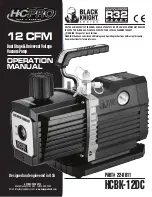
5 Installation at Site
39 of 116
CHTRa
3. Grouting the baseplate with concrete:
- Prepare the concrete shuttering for the baseplate and foundation pedestals up
to the planned grouting height.
- Make provisions for the grouting compound to bond with the foundation
concrete.
- Fill at least 1/3 of each field of the baseplate with non-shrinking grouting
compound (e.g. Pagel concrete grout), minimum compressive strength class C
25/30, grain size ≤ 8 mm. The remaining 2/3 of the fields may be filled with
standard concrete of this quality. KSB recommends that all fields be completely
grouted with non-shrinking concrete grout. Produce flowability with the help of
a solvent. Complete grouting without major interruptions.
- In order to avoid cavities, the grouting compound must be compacted.
4. When the grouting compound has set, check the nuts of the bonded anchors for
tightness once again using a torque wrench.
Observe the tightening torque!
5. Check coupling alignment and re-align, if necessary.
5.15.3 Securing the baseplate with special foundation bolts
1. Fill the special foundation bolt holes with dry sand.
2. Insulate the special foundation bolts in the area between the upper edge of the
foundation and the lower edge of the baseplate with Styrofoam or a similar
material.
3. Grouting the baseplate with concrete:
- Prepare the concrete shuttering for the baseplate and foundation pedestals up
to the planned grouting height as shown in the general arrangement drawing.
- Fill at least 1/3 of each field of the baseplate with non-shrinking grouting
compound (e.g. Pagel concrete grout), minimum compressive strength class C
25/30, grain size ≤ 8 mm. The remaining 2/3 of the fields may be filled with
standard concrete of this quality. KSB recommends that all fields be completely
grouted with non-shrinking concrete grout. Produce flowability with the help of
a solvent. Complete grouting without major interruptions.
- In order to avoid cavities, the grouting compound must be compacted.
4. When the grouting compound has set, check the nuts of the special foundation
bolts for tightness once again using a torque wrench. Observe the tightening
torque!
5. Check coupling alignment and re-align, if necessary.
5.16 Piping
DANGER
Improper connection of auxiliary lines
Explosion hazard from escaping leakage or fluid!
▷
Correctly install the auxiliary lines.
▷
Observe the maintenance and monitoring schedules.
5.16.1 Prerequisites
▪
The pump set has been earthed.
▪
The pipelines have been anchored in close proximity to the pump and connected
without transmitting any stresses or strains.
▪
With short pipelines, the nominal diameters should be at least equal to the
nominal diameters of the pump nozzles. For long pipelines, the most economical
nominal diameter has to be determined from case to case.
▪
Adapters to larger diameters should have a diffuser angle of approximately 8° in
order to avoid any pressure losses caused by the formation of air pockets.
















































